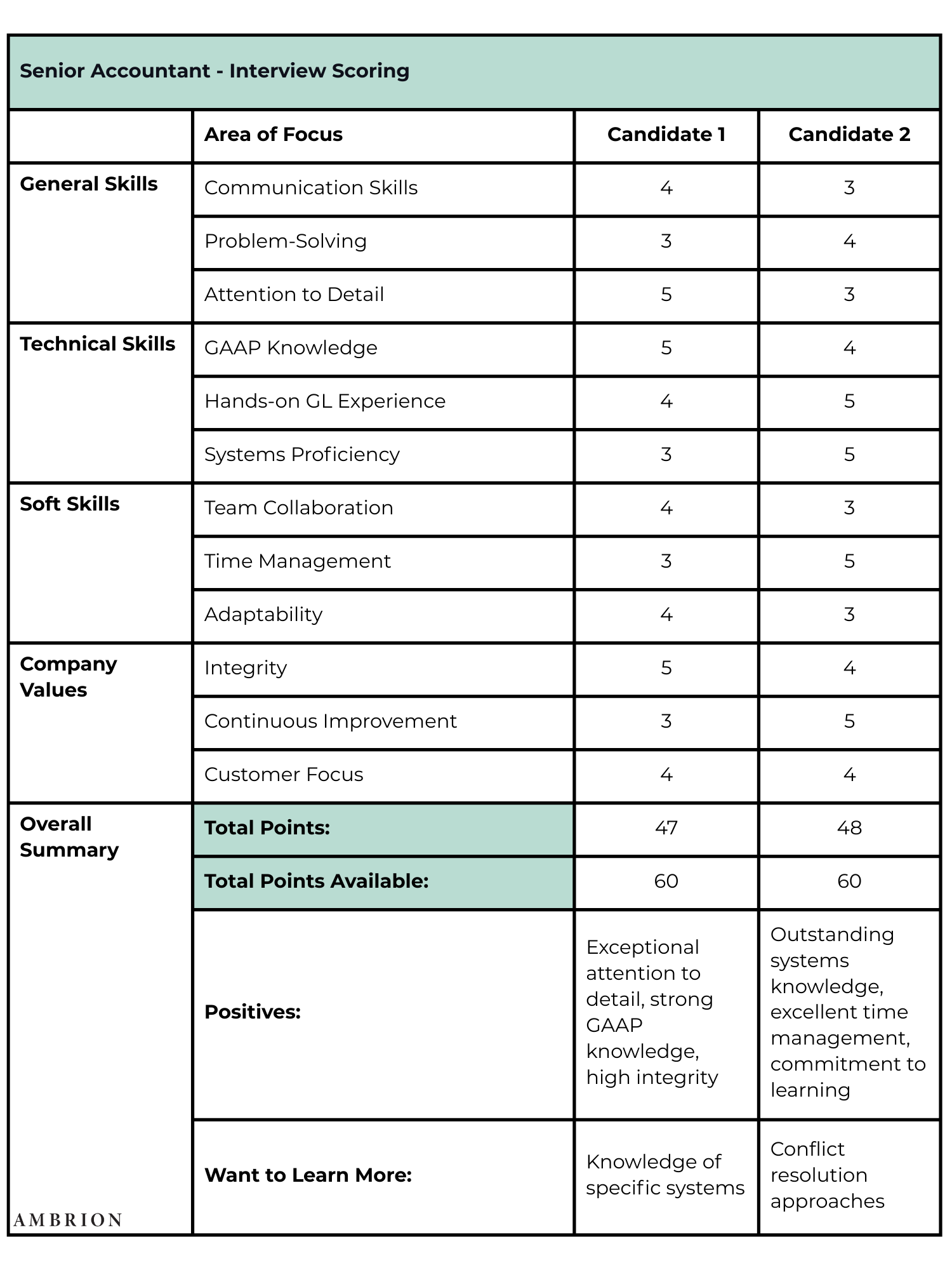Your team is only as strong as the people on it. But how do you identify the right talent in just 30-45 minutes of conversation? A thoughtful interview structure creates a level playing field for candidates while giving you consistent data points for decision-making. The result? Better hires, less bias, and a more cohesive team.
What is a Structured Interview?
![]()
A structured interview is where you ask each candidate the same questions in the same order. This creates a level playing field where everyone gets an equal chance to show their skills. AND it makes it easier for you to pick who moves forward in the process when everyone responds to the same questions.
Why Interview Structure Matters
![]()
Taking the time to create a thoughtful interview structure benefits everyone involved.
- Makes the process fair by comparing “apples to apples”
- Helps you focus on skills and first impressions
- Leads to better hiring decisions that align with company values (and culture)
- Shows candidates you value their time
- Supports fair hiring with a clear, consistent approach
How to Create an Effective Interview Structure
![]()
Define Success
First, take a step back. Think about what the purpose of this position is and what success will look like by asking yourself:
- What problem are you trying to solve with this hire?
- What skills and experiences should this person have?
- What outcomes will define success in this position?
Once you have a crystal-clear idea of what you need, you can create a targeted list of questions that directly probe the specific skills and experiences you’re seeking.
Create Strategic Questions
Your goal here is to create a set of questions that reveal how a candidate thinks, works, and fits into your team. Instead of using generic questions you found online, take time to create questions that will tell you something meaningful.
When making your list of questions:
- Keep coming back to your definition of success. What will this person need to know and do to excel?
- Ask things like “Tell me about a time when…” or “Walk me through how you’d approach…” These questions reveal real-world experience and problem-solving abilities (not just what someone thinks they might do in theory).
- Skip the yes-or-no questions (they won’t tell you much). Go deeper with questions that let candidates show their experience and how they communicate.
Structure Your Interview Flow
A great interview feels like a purposeful conversation, not an interrogation. Organize your questions so the interview flows naturally while still covering everything you need to know.
Here’s a simple structure that works well:
- Start with a warm introduction and a quick icebreaker
- Give an overview of your company and the role
- Ask about their background and listen to what they say and how they say it
- Weave in your questions about skills, problem-solving, and team fit as the conversation develops
You may not ask candidates the exact same questions, but you should make sure you cover the same territory. That way, you’re evaluating everyone fairly and consistently on what matters most:
- Can they do what the job requires?
- Will they work well with your team and embrace the company values?
Sometimes, the most revealing insights can come from spontaneous follow-ups like “Tell me more about that” or “Oh, you worked with [department]? How did that go?”
Create a Scoring System
Be consistent in how you evaluate each candidate. A simple 1-5 scale works well for most situations:
1: Needs growth – Minimal skill demonstrated
2: Basic – Understands the concept but needs development
3: Good – Meets role expectations
4: Great – Exceeds requirements
5: Amazing – Could lead others and elevate your team
Use this scale to build a scorecard that aligns with how you defined success earlier.
Here’s what this might look like in practice:

Complete Your Evaluation
Take a few minutes right after the interview to fill out your scorecard while everything’s fresh in your mind.
Ask yourself:
- Does this person have what it takes to succeed in this role?
- What moments from the conversation really stood out?
- What would I want to learn more about if they move forward?
When completing your evaluation, write key notes about the candidate in the “Positives” and “Want to learn more” boxes. This helps you plan additional questions for the second round of interviews.
For panel interviews, have everyone score independently before coming together to discuss. You’ll be surprised by what different people notice and pick up on. This approach helps balance out our natural biases and gives you a more complete picture of a candidate.
Tips for Great Structured Interviews
![]()
Listen Actively
- Give the person your full attention
- Show interest with your body language and eye contact
- Take notes without breaking the flow of the conversation
Ask Thoughtful Follow-Up Questions
- “I’d love to hear more about how you approached that challenge.”
- “Could you share what your specific contribution was to that team effort?”
- “What metrics or outcomes helped you know that your solution was successful?”
Be Consistent But Natural
- Ask core questions the same way to each person
- Let the conversation flow naturally
- Don’t hint at what answers you want to hear
Be Aware of Your Own Views
- Base your ratings on clear examples, not just feelings
- Judge against job needs, not personal taste
- Take breaks between interviews to clear your mind
Common Mistakes to Avoid
![]()
- Talking too much: Give candidates plenty of time to share
- Leading questions: Don’t prompt what answer you want
- Poor preparation: Know the person’s background before you meet
- Shifting standards: Use the same rating system for everyone
Final Thoughts
![]()
Good interviews build great teams. This structured approach helps you spot talent consistently while giving candidates a positive experience. Give it a try with your next 3 interviews and see how much easier it becomes to make confident hiring decisions!
Related Blogs You’ll Enjoy
![]()
- Interview Questions: What To Ask and Avoid
- From Offer to First Day: 6 Preboarding Steps for Managers
- Land Top Talent with These 10 Interviewing Tips

